
Line 1, shortened to L1, coloured red and often simply called Línia vermella, is the second oldest Barcelona Metro line, after line L3. It is the longest line of the Barcelona Metro, and links L'Hospitalet de Llobregat and Santa Coloma de Gramenet. Originally operated by the independent Ferrocarril Metropolitano Transversal de Barcelona, it is today operated by Transports Metropolitans de Barcelona (TMB) and is part of the ATM fare-integrated main transport system. L1 is the only metro line in Spain to use Iberian gauge tracks, as used by most Spanish main line railways.
Line 3, currently known as Zona Universitària – Trinitat Nova, coloured green and often simply referred to as Línia verda, is a metro line in Barcelona operated by TMB, and therefore part of the fare-integrated ATM transport network of the urban region. This V-shaped line is the result of the junction of two related lines: the original L3 and L3B, in 1982. The central section of L3 has the city's oldest metro stations, built in the mid-1920s, with additions almost every decade since then. All of L3 stations are underground.

Line 4, also known as Trinitat Nova – La Pau, usually called "línia groga", is a line in the Barcelona Metro network operated by TMB, and part of the ATM fare-integrated transport network. It serves the northern districts of the city, and it is being extended to the new major metro and rail stations Estació de la Sagrera and Sagrera-Meridiana.

Line 9 is a completely automated line of the Barcelona Metro network that is currently under construction, with 24 stations open in Barcelona and El Prat de Llobregat, L'Hospitalet de Llobregat, Badalona and Santa Coloma de Gramenet suburbs, since December 2009. The line is currently disconnected in two branches, with a connecting part between the two yet to be built. The Aeroport T1 – Zona Universitària section is called L9 South, and the La Sagrera – Can Zam portion L9 North. Upon completion, it will be the longest underground metro line in Europe.

Trinitat Nova is a Barcelona Metro station, named after the nearby La Trinitat Nova neighbourhood, in the Nou Barris district of the city of Barcelona. The station is served by lines L3, L4 and L11.
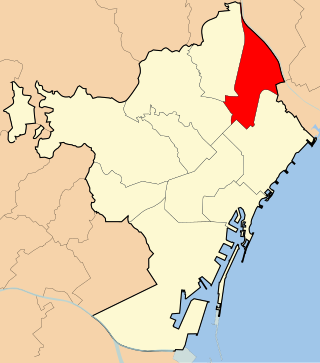
Sant Andreu is one of the ten districts of Barcelona since its redistricting in 1984. It was named after the former municipality of Sant Andreu de Palomar, which was the largest in the area and now makes up the bulk of the neighbourhood bearing its name, as well as part of the neighboring district of Nou Barris.
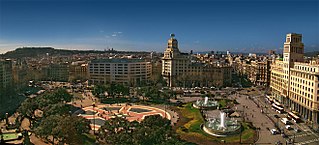
Plaça de Catalunya is a large square in central Barcelona that is generally considered to be both its city centre and the place where the old city and the 19th century-built Eixample meet.

Fondo is a Barcelona Metro station in the municipality of Santa Coloma de Gramenet, in the northern part of the metropolitan area of Barcelona. It is served by two metro lines, L1, of which it is the northern terminus, and L9. It was built in 1992 under Camí Fondo de Badalona, in the neighbourhood of Fondo, between Carrer Dalmau and Carrer Verdi.

Passeig de Lluís Companys is a promenade in the Ciutat Vella and Eixample districts of Barcelona, Catalonia, Spain, and can be seen as an extension of Passeig de Sant Joan. It was named after President Lluís Companys, who was executed in 1940. It starts in Arc de Triomf and ends in Parc de la Ciutadella, on Carrer de Pujades.

La Rambla | Drassanes is a Barcelona Metro station located underneath Portal de la Santa Madrona, just off La Rambla in the Ciutat Vella district of Barcelona. It is named after the nearby Drassanes Reials de Barcelona, the old shipyards that are now the home of the Museu Marítim de Barcelona. It is the closest station to the Port of Barcelona and one of the network's closest stations to the sea, and is served by TMB-operated Barcelona Metro line L3.
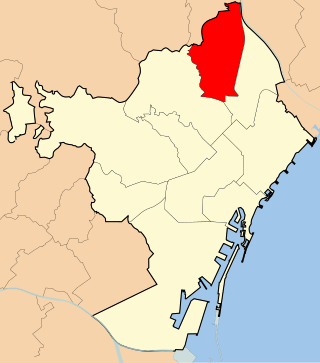
Nou Barris is one of the ten districts into which Barcelona has been officially divided since 1984. The name refers to the original nine neighbourhoods it was composed of, even though nowadays it's made up of thirteen. It covers an area of 8.04 km2.
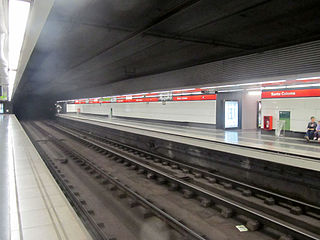
Santa Coloma is a Barcelona Metro station in Santa Coloma de Gramenet, a municipality of the metropolitan area of Barcelona. It's served by L1. It opened in 1983 and is located under Passeig Llorenç Serra. Platforms are 99 m (325 ft) long.
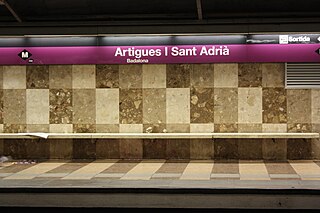
Artigues | Sant Adrià is a Barcelona Metro station in Badalona, named after the neighbourhood of the same name. Despite the latter part of the name, it is not in Sant Adrià del Besòs, and the tag Badalona was added to all signage in the station to avoid confusion. It is served by L2. It opened in 1985 with the name Joan XXIII as part of L4 and became a L2 station in 2002. It can be accessed from Carretera de Santa Coloma and from Avinguda de Joan XXIII.

Torras i Bages is a station of the Barcelona Metro, on L1. Opened in 1968, it serves the northern part of the Sant Andreu de Palomar neighbourhood in the Sant Andreu district. It was one of the termini of this subway line until 1983, when it was extended into Santa Coloma de Gramenet. The station does not include accessibility facilities as of 2008. It has two 107-metre-long platforms, and it is unusual for a subway station of this kind in having three railtracks as opposed to two, due to its former role as line terminus. The current railtrack leading to Fondo is actually a secondary one.
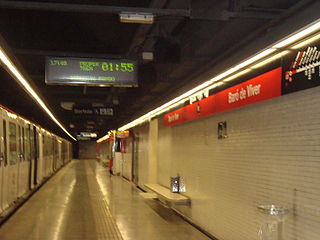
Baró de Viver is a station of the Barcelona Metro, in the Baró de Viver area of Sant Andreu, a northern district of Barcelona. It is operated by Transports Metropolitans de Barcelona (TMB) and served by L1. The station opened in 1983 as the line grew from its terminus in Torras i Bages towards the municipality of Santa Coloma de Gramenet. It is located under the southern side of the busy Nus de la Trinitat, next to the Besòs river bank.
La Trinitat Nova is a neighborhood in the Nou Barris district of Barcelona, Catalonia, Spain.
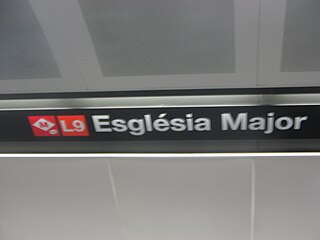
Església Major is a Barcelona Metro station in the municipality of Santa Coloma de Gramenet, in the northern part of the metropolitan area of Barcelona underneath Plaça dels Enamorats. The station is named after the town's main church, located in Plaça de l'Església. It's served by L9 and is one of the stations comprising the first part of Line 9 to be opened, between Can Zam and Can Peixauet, inaugurated on 13 December 2009. Sanchez-Piulachs, Arquitectes S.L were in charge of the design of Església Major.

Singuerlín is the name of a Barcelona Metro station in the municipality of Santa Coloma de Gramenet, in the neighbourhood of Singuerlín, located in the northern part of the metropolitan area of Barcelona. It's served by L9, the first part of Line 9 to be opened, between Can Zam and Can Peixauet.


















